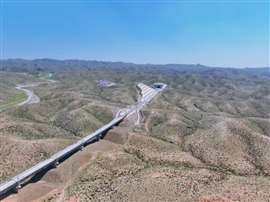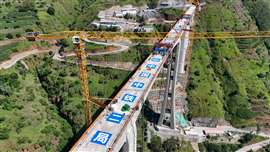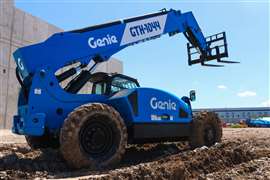Read this article in Français Deutsch Italiano Português Español
China: What do top contractors’ results tell us about the construction market?
22 September 2025
 A construction site in Changsha, China, where residential developments have started to become a rarer sight (Image: KHL Group)
A construction site in Changsha, China, where residential developments have started to become a rarer sight (Image: KHL Group)
China’s construction sector is no longer defined by breakneck expansion.
Up until recently, seemingly relentless housing demand and massive infrastructure schemes propelled the Middle Kingdom’s construction sector forward.
But those engines of growth are slowing: the collapse of Evergrande Group, at one time the world’s most value real estate company, serving as a prime example of how residential construction has hit the buffers in China.
According to national data, China’s construction industry achieved a total output value of CNY 13.67 trillion (US$1,913.8 billion) in the first half of 2025. While it’s a huge figure, it has increased just 0.2% year on year.
National investment in residential property declined by 10.4%. The picture was slightly more positive for infrastructure investment, which increased 4.6% year on year.
At the same time, overseas contracting turnover and new orders are increasing, and investment in water, energy and green infrastructure is accelerating.
And as the latest financial updates from China’s four biggest state-owned contractors (CSCEC, CCCC, CRCC and CREC) show, they are alive to the shift going on in the country’s construction sector.
Together, their latest half-year results provide a snapshot of a sector under pressure but repositioning itself for new opportunities both domestically and abroad. The figures show where the strains lie, where the growth is coming from, and where Beijing wants the industry to go next.
Construction Briefing examines how China’s four-biggest construction companies fared in the first half of 2025:
1) China State Construction and Engineering Corporation (CSCEC)
CSCEC, the world’s largest contractor by revenue, posted modest growth in the first seven months of 2025. New contracts rose 1.4% year-on-year to CNY2.68 trillion ($375.2bn), with construction contracts up 2.1% to CNY2.49 trillion ($348.6bn).
Housing contracts remained the largest component at CNY1.63 trillion ($228.2bn), although the domestic residential market continues to contract. Infrastructure accounted for CNY853.3 billion ($119.5bn), while overseas contracts totalled CNY127.3 billion ($17.8bn).
The figures point to resilience in infrastructure and overseas work, offsetting weakness in domestic housing. Although the housing segment still represents the bulk of CSCEC’s business, the limited growth suggests the company is maintaining volumes rather than expanding.
Meanwhile, the relatively small proportion of overseas contracts indicates continued reliance on China’s internal market.
2) China Communications Construction Company (CCCC)
CCCC lays claim to being the world’s largest port, road and bridge design and construction company and its interim results underline the pressures the construction sector in China faces.
Revenue for the first half of 2025 fell 5.8% year-on-year to CNY335.45 billion ($47 billion), with gross profit down 14% and operating profit down 16.2%. Despite this, the company reported new contracts worth CNY991.1 billion ($137.7 billion), up 3.1% year-on-year.
Overseas business remained a bright spot, with new contracts valued at CNY200.4 billion ($28.1 billion), up 2.2%. Emerging industries, particularly energy conservation, environmental protection, new energy and new materials, also expanded, reaching CNY320.3 billion ($44.8 billion).
And the company has set an ambitious full-year target of not less than 7.1% growth in new contracts and 5% revenue growth.
In its statement, CCCC emphasised a strategic pivot towards “innovation, green development, digital intelligence, integration, and sustainability”. It launched the BlueWing-LLM, described as the first AI large language model for the civil engineering sector, now in use across more than 30 scenarios.
Management also stressed alignment with national strategies such as the Belt and Road Initiative, seeing overseas infrastructure as central to future growth. CCCC claims to operate in 139 different countries around the world.
 CCCC built the Bintulu-Jepak bridge in Malaysia, which opened to traffic in March 2025 (Image courtesy of CCCC)
CCCC built the Bintulu-Jepak bridge in Malaysia, which opened to traffic in March 2025 (Image courtesy of CCCC)
3) China Railway Construction Corporation (CRCC)
CRCC reported a 5.2% fall in revenue to CNY489.2 billion ($68.5 billion) for the first half of 2025, with total profit down 14%.
In the first half of 2025, the value of newly signed contracts amounted to CNY1,056.2 billion (US$146.7 billion), representing a year-on-year decrease of 4%. Newly signed domestic contracts fell 8.4% to CNY942.1 billion (US$130.8 billion). Domestic contracts still accounted for 89.2% of CRCC’s total amount of newly-signed contracts. But there was a big increase of 57.4% in newly signed overseas contracts, totalling CNY114.1 billion (US$15.9 billion).
Commenting on its construction operations in its latest interim report CRCC noted that, “Significant divergence emerged across construction operation subsectors, with rapid growth in fixed-asset investment in water conservancy, energy, and power projects, while declines were seen in building construction, highways and municipal engineering.”
It added, “China’s construction operation industry has now entered a critical phase of transforming its development model and shifting growth drivers.”
 CRCC recently completed the 8.8km-long Helan Mountain tunnel between the Alxa Left Banner in Inner Mongolia and Yinchuan in the Ningxia autonomous region. It forms part of the Baoyin high-speed railway, Yingba Branch (Image courtesy of CRCC)
CRCC recently completed the 8.8km-long Helan Mountain tunnel between the Alxa Left Banner in Inner Mongolia and Yinchuan in the Ningxia autonomous region. It forms part of the Baoyin high-speed railway, Yingba Branch (Image courtesy of CRCC)
4) China Railway Group (CREC)
CREC reported revenue of CNY512.5 billion ($71.8 billion), down 5.9% year-on-year. Infrastructure construction, which is by far its largest business line, was down 7.5%. However, new orders totalled CNY1.11 trillion ($155.4bn), up 2.8%, driven by a 51.6% increase in overseas contracts to CNY124.9 billion ($17.5bn).
It also secured orders totalling CNY143.3 billion (US$19.9 billion) in what it called its “second curve” businesses, including water conservancy, energy, and ecological and environmental protection.
The company highlighted national policy support, including ultra-long-term government bonds and targeted infrastructure investment, as stabilising factors. It also pointed to a shift in urbanisation policy, noting that China’s urban growth is moving from “large-scale incremental expansion” to improving “the quality and efficiency of existing stock”. As CRCC noted, this reflects a structural reorientation from rapid building to renewal, refurbishment and optimisation.
Meanwhile, as part of its R&D activities CREC has developed intelligent construction robots for railways, new vibration control systems for high-speed bridges, and advanced underground engineering technologies. These efforts align with the government’s call for “new quality productivity” in infrastructure.
 Tower cranes operate alongside the Jiangdi Niulanjiang Bridge during its construction (Image courtesy of China Railway Group)
Tower cranes operate alongside the Jiangdi Niulanjiang Bridge during its construction (Image courtesy of China Railway Group)
From expansion to transformation
The sheer scale of China’s construction output helps to mask the fact that behind the scenes, a shift is starting to take place.
The country’s biggest contractors are finding it harder to replicate the big gains in revenue that they enjoyed in previous years, as the sector moves beyond the rapid build-out that characterised the past two decades.
Instead, the focus now is shifting upgrading existing stock, digitalisation, and sustainability.
What remains to be seen is how far the transformation being heralded by China’s construction titans can offset the drag from the ailing residential property market.
STAY CONNECTED


Receive the information you need when you need it through our world-leading magazines, newsletters and daily briefings.
CONNECT WITH THE TEAM










